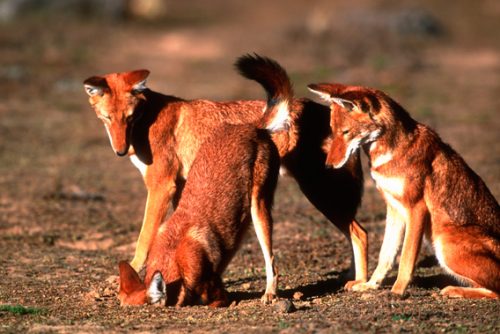The Ethiopian wolf (Canis simensis) is the rarest of the canids. It is the most vulnerable wolf species. Although it is a medium-size mammal yet it survives mainly on small rodents. They occur in the Ethiopian Highlands. There are less than 500 Ethiopian wolves remaining in the wild. They make habitats at high altitudes of about 4,000 meters.
Ethiopian Wolf Facts
Anatomy
- The adult wolf is nearly the size of a coyote but it is larger than jackals. They have broad ears and long legs. The head-body length of the wolf measures around 841–1,012 millimeters (33.1–39.8 in) and stands 530–620 millimeters (21–24 in) at the shoulder.
- Male wolves weigh up to 14.2–19.3 kg (31–43 lb), while females average 11.2–14.15 kg (24.7–31.2 lb).
- Unlike other wolf species, the Ethiopian wolf has long and narrow skull.
- The reddish coat has got white undersides and neck and there is a sharp line that divides the red coat and white marks.
- During the breeding season females change its coat color from red to yellow.

Range & Habitat
- In Ethiopia wolves occur on the north of Rift Valley, Wollo highlands, north Shoa, Simien Mountains, and Guassa Menz. The population also lives in the Mount Choqa, Arsi, Bale Mountains, and Mount Guna.
- They live on Ethiopian mountains at a height of about 9,840 ft (3,000 m).
- Ethiopian wolves are likely to make homes on heathlands and Afroalpine grasslands. These habitats also provide many species of rodents.
- While most animals live up to a height of about 3,200 m there are some that are found at 3,700 meters above the ground. They prefer to build habitats in Bale Mountains because the mountains are abundant in herbs and grasses.
- The northern population seems to rely on giant lobelias and Festuca
Behavior
- Like most other wolves, Ethiopian wolf is a social animal as it is thought to live in small to medium-size packs. There are around 6 to 20 individuals in one group.
- There is a top-down chain of command in wolves’ packs with the dominant wolf leads the group. When the dominant female dies her daughter claims her position in a group.
- Each pack marks a territory and the home range is 6 km2 (2.3 sq mi).
- Packs are less likely to accept members of other groups but they only do so when one of the packs disappears.
- The size of the group also depends on the availability of small rodents because rodents are the primary diet of Ethiopian wolves.
- They spend night resting in groups but the group travels at dawn.
- During rain, Ethiopian wolves will seek shelter in boulders and overhanging rocks.
- They will use dens only for rearing young. Wolves never sleep in dens.
- Wolves actively defend their territories and any intruder any at all is dealt strongly.
Feeding Ecology & Diet
- Ethiopian wolves are one of the few carnivores that rely almost exclusively on small rodents. Wolves become active during the day because many rodents come out at in daytime.
- Important among rodents is the calves of mountain nyala and big-headed mole-rats. The long-pointed jaws of the wolf allow them to catch rodents. They locate their prey by the sounds it (prey) produces with its feet.
- Ethiopian wolf’s diet also consists of highland hares, yellow-spotted brush-furred rats, goslings, eggs, and grass rats. They also consume Abyssinian grass rats and East African mole-rat.
- Before the final rush wolves go as close as 33–66 ft (10–20 m) to the prey. After this they strike their prey with the snapping speed.
- They don’t hesitate to prey on large rodents such as giant mole rat averaging 10.6–31.7 oz (300–900 g) in weight. However wolves typically consume small rodents.
- They are also scavengers.
- Ethiopian wolves can also dig sand if they can locate the exact spot of the newborn rats.

Reproductive Biology
- Ethiopian wolves mate from August to November.
- The gestation period lasts about 2 months. In the months of October and December pups are born.
- Pups show grey coat but their eyes are closed at birth.
- The female gives birth to 2 – 6 pups. They will leave the den in 21 days.
- The young wolf begins to eat solid food when it is 35 days old. They become completely independent in about 70 – 180 days.
- All the group members look after the pups. They become mature at 2 years of age.
Conservation Status
Endangered

Leave a Reply